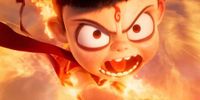In a year filled with cinematic surprises and record-shattering numbers, few stories have captured the global imagination quite like the rise of Ne Zha 2. This animated fantasy epic, directed by Chinese filmmaker Jiaozi and released in January 2025, has stormed the box office in ways few could have predicted—even in a landscape accustomed to billion-dollar blockbusters. Now, with an English-dubbed version set to hit U.S. theaters on August 22, the film stands on the brink of overtaking Titanic as the fourth-highest grossing movie of all time, potentially rewriting the record books and challenging Hollywood’s long-held dominance.
For many American moviegoers, Ne Zha 2 might still be an unfamiliar name. Yet, according to Box Office Mojo and other industry trackers, the film has already amassed more than $2.2 billion globally, with a staggering 88% of that haul coming from China alone. That makes it not only the highest-grossing film of 2025, but also the highest-grossing animated film and the most successful non-English-language movie in history. To put this in perspective, Star Wars: The Force Awakens—the previous record-holder for single-country box office—earned $936.6 million in the U.S., less than half of Ne Zha 2’s China take.
So, what is Ne Zha 2 all about? The film is a sequel to the 2019 hit Ne Zha, itself a runaway success in China, and draws heavily from Chinese mythology and the classic 16th-century novel Investiture of the Gods. The story follows Ne Zha, a rebellious demigod born to human parents, as he wrestles with uncontrollable powers and a destiny that pits him against ancient forces threatening humanity. This time, Ne Zha and his friend Ao Bing—reincarnations of two halves of a powerful Chaos Pearl—must share a body and face a series of demon-hunting trials, all while their hometown faces destruction at the hands of the Dragon King. The plot, as reviewers have noted, is dense and packed with betrayals, magical showdowns, and references to Taoist lore that might leave Western audiences a bit dizzy, especially if they haven’t seen the original film. (For those looking to catch up, the first Ne Zha is available to stream on Peacock in the U.S.)
But if the narrative complexity is daunting, the visuals are anything but. Critics have praised the film’s “breathtaking” animation, with sequences that include heavenly demon hunters transforming into golden leaves, rivers of lava tearing through the sky, and a jade palace that glistens with otherworldly beauty. According to The Atlantic, “the animation is some of the best I’ve seen out of any country,” a sentiment echoed by a 94% critics’ rating on Rotten Tomatoes. Even detractors admit that the film’s 144-minute runtime is filled with enough visual spectacle to justify its length, even if some of the extended fight scenes begin to blur together.
Of course, box office success is rarely just about craft. Ne Zha 2’s meteoric rise has sparked heated debates about what’s really driving its popularity. Some English-language outlets, such as IndieWire and BBC News, have pointed to a surge in Chinese nationalism, with claims that “rising nationalist sentiment is a key factor in the success of Ne Zha 2,” and that the film contains “plenty of digs at imperialism” and even the U.S. itself—if you know where to look. Social media posts cited by Reuters have called for Hollywood competitors like Captain America: Brave New World to “die” at the Chinese box office, and some Chinese viewers have interpreted certain symbols in the film as sly references to American power, from a white jade palace (evoking the White House) to a pendant resembling a bald eagle.
Yet, as Chinese American critics have pointed out, the reality is more nuanced. “After all, it’s not as if America invented hypocrisy,” one reviewer quipped, noting that some Chinese audiences see the film’s villain as a stand-in for the Chinese Communist Party rather than a foreign adversary. The politics, much like the mythology, are open to interpretation—and perhaps that’s part of the film’s universal appeal. “Chinese people aren’t a monolith, and they aren’t all driven by a red-tinted bloodlust for national dominance,” the same critic observed, pushing back against simplistic readings of the film’s success.
There has also been speculation about the role of organized group outings and discounted tickets in boosting Ne Zha 2’s numbers. While some have suggested this points to astroturfing or artificial inflation, others note that such practices are common in both China and the U.S.—think of companies taking employees to see major releases, or fans watching favorites like Titanic and Avatar multiple times. The film’s release over the Chinese New Year holiday, a prime moviegoing period, certainly didn’t hurt either.
Now, with A24—best known for indie darlings like Everything Everywhere All at Once—teaming up with China’s CMC Pictures to distribute the English-dubbed version, Ne Zha 2 faces its biggest test yet: Can a Chinese animated epic capture the imagination of American audiences? The U.S. release, which includes IMAX screenings and a star-studded voice cast led by Michelle Yeoh, Crystal Lee, Vincent Rodriguez III, Aleks Le, and Damien Haas, is being closely watched as a “litmus test of the U.S. market’s appetite for Chinese storytelling.”
The stakes are high. With just $60 to $65 million more needed to overtake Titanic’s $2.264 billion global haul, even a modestly successful U.S. run could propel Ne Zha 2 into the top four all-time box office rankings, trailing only Avatar, Avengers: Endgame, and Star Wars: The Force Awakens. It would also cement A24’s reputation as a studio capable of transcending borders and genres, potentially making Ne Zha 2 its highest-grossing film ever.
Yet, as some commentators have noted, the film’s fate in the U.S. is far from assured. American audiences have long been wary of foreign-language and foreign-made films, especially those not tied to familiar franchises or genres. “It may still be a lot to ask American audiences who have long been inculcated with Sinophobic beliefs to fork over money for an overtly Chinese movie that’s not Kung Fu Panda and that happens to be a sequel to a different Chinese film they’ve never heard of,” one critic wrote. But, as they added, if Ne Zha 2 flops, let it be on its own merits—not because of “reductive fearmongering.”
For now, all eyes are on August 22. Will Ne Zha 2 become a true global phenomenon, or will it remain a uniquely Chinese success story? Whether you’re a fan of dazzling animation, epic mythology, or just curious to witness a potential box office milestone, the arrival of Ne Zha 2 in American theaters promises to be one of the most intriguing cinematic events of the year.
As the credits roll and the numbers continue to climb, the world will be watching to see just how far this mythic hero—and the film that bears his name—can go.

